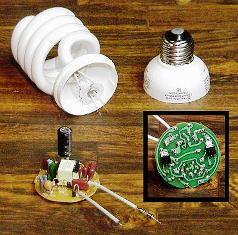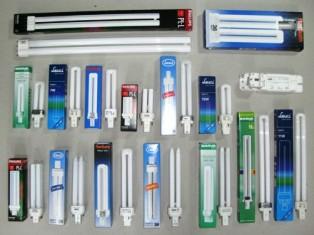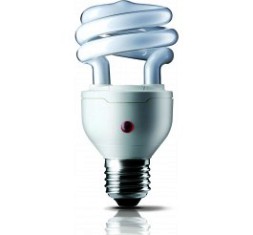Categories: Electrician at home, Sources of light, How does it work
Number of views: 76317
Comments on the article: 11
How are compact fluorescent lamps
 First fluorescent lamps were created in the USA in the 30s of the last century. Their active implementation began in the 50s and 60s. Currently, fluorescent lamps in their distribution occupy the second place in the world after incandescent lamps.
First fluorescent lamps were created in the USA in the 30s of the last century. Their active implementation began in the 50s and 60s. Currently, fluorescent lamps in their distribution occupy the second place in the world after incandescent lamps.
One of the main disadvantages of conventional linear fluorescent lamps is their size. And if this parameter is not so important in office buildings and industrial enterprises, in everyday life, despite their high economic efficiency, this greatly limited the use of such light sources.
Manufacturers of fluorescent lamps have always sought to reduce their size. And only in the 80s after the creation of new high-quality phosphors it was possible to reduce the diameter of the lamp tube to 12 mm and bent it many times to get a lamp with a compact design. Over time, lamp manufacturers managed to reduce their size and weight so much that they became able to replace incandescent lamps almost everywhere.
So was born compact fluorescent lamp, by the way, being a champion among all lamps by possible names. As soon as it is not called - “energy-saving lamp”, “housekeeper”, “energy-saving lamp”, “speaker” ... Many of these names are not entirely correct, since, for example, other light sources can also be used under the name “energy-saving lamp”, for example, LED lamp, or high pressure sodium lamps (DNaT), which are used to illuminate the streets and shops of industrial enterprises.

Fig. 1. Compact fluorescent lamp (energy-saving lamp)
How does a compact fluorescent lamp work?
A compact fluorescent lamp (CFL) consists of two main elements: a base and a bulb.
IN flask compact fluorescent tubes are tungsten electrodeson which activating substances are applied (a mixture of barium, calcium, strontium oxides). The flask is filled with an inert gas with a small amount of mercury vapor (they ionize and glow when the lamp is on) and is bent several times.
When voltage is applied to the lamp, an electric charge arises between the electrodes and it ignites. When the lamp is in operation, most of the light it generates lies in the ultraviolet range (about 98% of all radiation). In order to convert this radiation into light, the inside of the lamp bulb is covered phosphor. Lyuminophore being irradiated with ultraviolet radiation begins to glow. The color of this light depends on the composition of the phosphor. In fact, the efficiency of the lamp depends on the quality of the phosphor, because it is the phosphor that determines its lighting parameters.
In the production of compact fluorescent lamps, three and five-layer are used. rare-earth phosphors. Such phosphors are approximately 30 to 40 times more expensive than those used in conventional linear fluorescent lamps. These phosphors can work at higher surface radiation densities. Due to this, it turned out decently to reduce the diameter of the discharge tube of the lamp. To reduce the lamp length, the discharge tube was divided into several interconnected short sections.

Fig. 2. Compact fluorescent lamp device
Fluorescent lamps cannot work directly connected to the network. To work, they require special assistive devices known as ballasting equipment. Most often, compact fluorescent lamps use modernuh electronic ballast control equipment (electronic ballasts).
Ballasts of compact fluorescent lamps (sometimes called electronic ballasts) are powered by high-frequency voltage (up to 50 kHz), due to which there is no unpleasant flickering of lamps, their luminous flux and, accordingly, light output are increased. A high-frequency current is obtained by converting it using an inverter, which converts the rectified current into high-frequency pulses.
In addition, the electronic ballast during operation increases the power factor (it approaches 1) and the lamp, as a consumer of electricity, becomes like a purely active load (no need to compensate for cos fi). At the time of starting, the electronic ballast preheats the electrodes, and during operation it maintains the nominal value of the lamp power during fluctuations in the supply voltage. The service life of compact fluorescent lamps largely depends on the quality and reliable operation of the electronic ballasts.
All compact fluorescent lamps can be divided into 2 groups: lamps with external ballasts or electronic ballasts and lamps with integrated electronic ballasts.
Lamps of the first type are available with special 2 and four pin sockets. In the cap of 2-pin lamps, starters and capacitors are built-in to suppress interference. In order to turn on such a lamp, you need a choke. With this type of lamp are often used in table lights.
With electronic ballasts, such lamps cannot be connected, since the starter integrated in the base will not allow the lamp to turn on. 4-pin lamps can be switched on with both a choke and electronic ballasts, although there are lamps that are not designed to work with chokes, but only work with electronic ballasts.
Socles such lamps may vary (there are about 20 different types of socles). In fact, each lamp of a certain power has its own type of cap, which will not allow anything to be confused and include a lamp of a different power in the armature.

Fig. 3. Compact fluorescent lamps for working with external electronic ballasts
Compact fluorescent lamps of the second group with integrated electronic ballasts (integrated in the lamp base) are available with threaded caps E27 and E14 (minion). They are intended for direct replacement of incandescent lamps without replacing fixtures.
There are compact fluorescent lamps with a color close to incandescent lamps with a color temperature of about 2700 g.aboutK (ordinary CFLs have a color temperature of 3330 to 6500 aboutTO). This will delight those who are uncomfortable with white light coming from compact fluorescent lamps.
Compact fluorescent lamps are available in power from 5 to 55 watts. The most common lamps are 5, 7, 9, 11, 15, 20, 23 watts. Larger lamps are large in size and difficult to use instead of incandescent lamps.

Fig. 4. Compact fluorescent lamps with integrated electronic ballasts
The average life of compact fluorescent lamps is 10 thousand hours. Some manufacturers promise customers a service life of up to 15 thousand hours. The most reliable manufacturers of compact fluorescent lamps: PHILIPS, OSRAM, Sylvania, General Electric.
Compact fluorescent lamps cannot be used with dimmers (dimmers) There are special electronic ballasts that support the function of changing the luminous flux of a lamp, but firstly they are rare, secondly they are more expensive than conventional electronic ballasts, and thirdly, mainly such electronic ballasts are available for linear fluorescent lamps, i.e. they are intended, to a greater extent, for automation and centralized control of lighting in office buildings.
Therefore, if you are going to replace an incandescent lamp with a compact fluorescent lamp, and you have a dimmer as a switch, then think about where it is better to move it, and use conventional classic switches to connect the lamp with CFL.
In addition to standard lamas, there are also many unusual light sources of this type, which have an unusual design or any technical know-how.For example, Philips produces the Tornado ESaver Automatic lamp, which is designed for outdoor lighting and has a built-in photocell that turns the lamp on and off when the light changes.

Fig. 5. Philips Tornado ESaver Automatic compact fluorescent lamp
From the foregoing, we can conclude: do not chase cheap compact fluorescent lamps. Think, if a lamp is cheap, it means that it was saved somewhere in its manufacture. The compact fluorescent lamp is a sophisticated technical device with electronic filling. In an effort to save money, there is a very high probability that we can run into a low-quality lamp with cheap electronics. Buy lamps only from trusted and reliable manufacturers!
Read also:Causes of the flashing compact fluorescent lamp and how to fix it and Comparison of power and light output of various types of lamps
See also at bgv.electricianexp.com
:
